实验3:OpenFlow协议分析实践
实验3:OpenFlow协议分析实践
一、实验目的
- 能够运用 wireshark 对 OpenFlow 协议数据交互过程进行抓包;
- 能够借助包解析工具,分析与解释 OpenFlow协议的数据包交互过程与机制。
二、实验环境
- 下载虚拟机软件Oracle VisualBox;
- 在虚拟机中安装Ubuntu 20.04 Desktop amd64,并完整安装Mininet;
三、实验要求
(一)基本要求
1.搭建下图所示拓扑,完成相关 IP 配置,并实现主机与主机之间的 IP 通信。用抓包软件获取控制器与交换机之间的通信数据包。
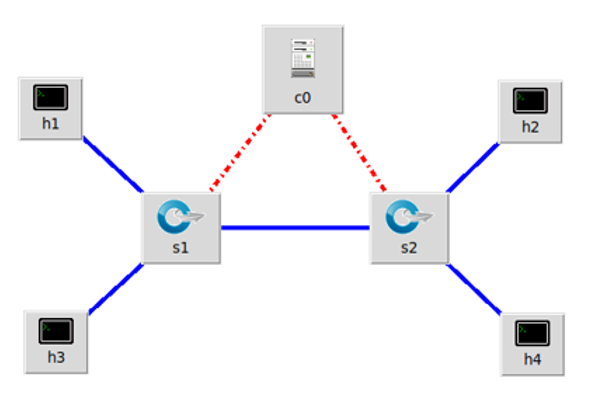
- 使用可视化界面工具构建拓扑同时配置对应网段

- 把导出的拓扑文件保存在/home/用户名/学号/lab3/目录下

2.查看抓包结果,分析OpenFlow协议中交换机与控制器的消息交互过程,画出相关交互图或流程图。
-
交互图
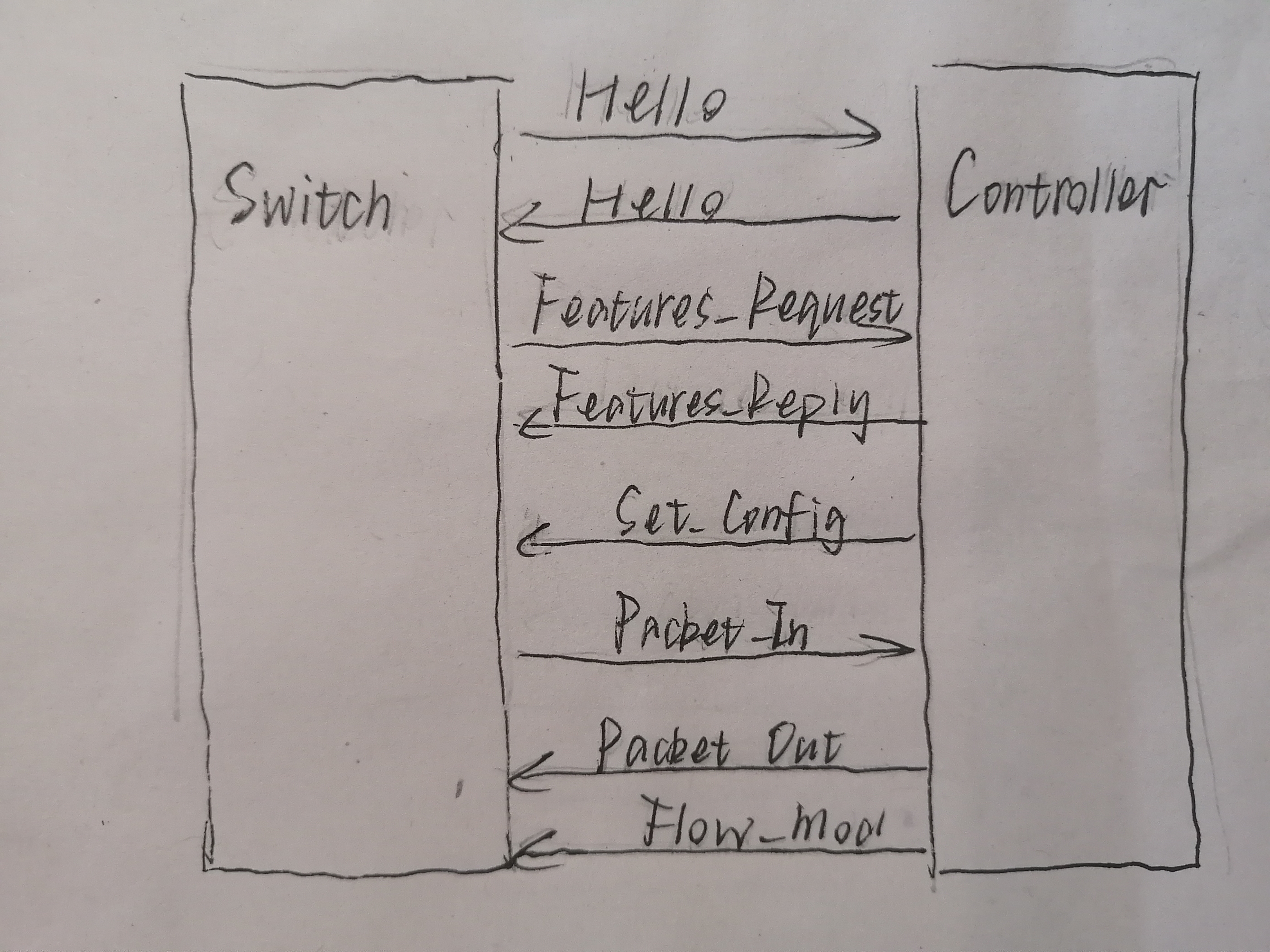
-
Hello
- 控制器端口 ----> 交换机端口 (图中可以看出,控制器端使用OpenFlow1.0版本)

- 交换机端口 ----> 控制器端口 (图中可以看出,交换机端使用OpenFlow1.5版本)

因此,控制器和交换机双方最终采用OpenFlow1.0版本进行交互
- 控制器端口 ----> 交换机端口 (图中可以看出,控制器端使用OpenFlow1.0版本)
-
Features Request
- 控制器端口(我需要你的特征信息) ---> 交换机端口
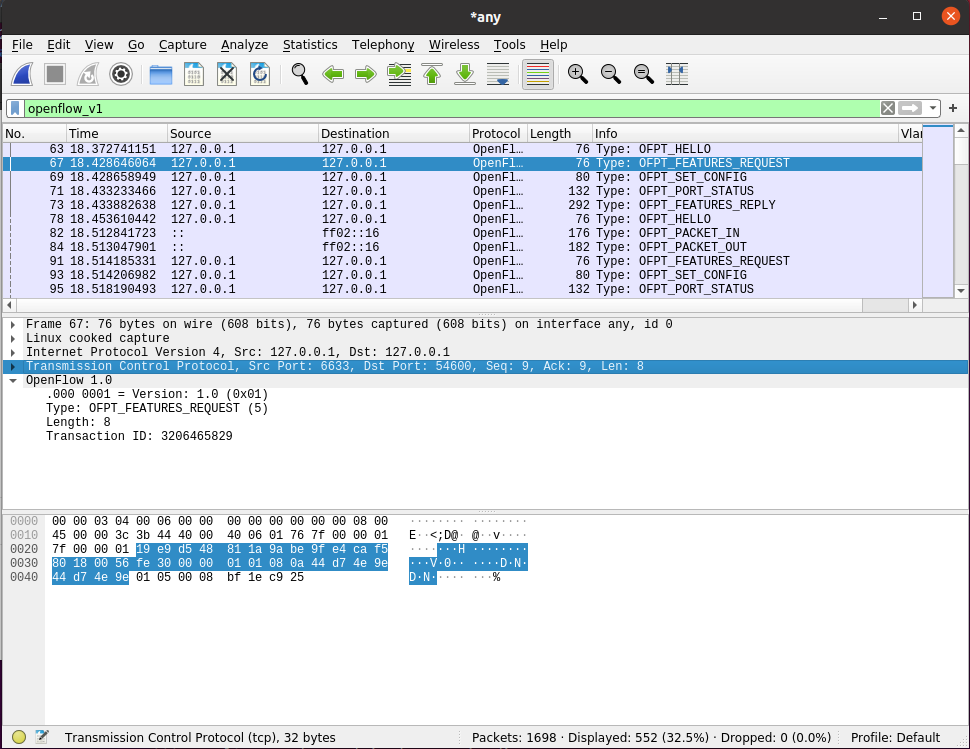
- 控制器端口(我需要你的特征信息) ---> 交换机端口
-
Features Reply
- 交换机端口(这是我的特征信息,请查收)--- 控制器端口

- 交换机端口(这是我的特征信息,请查收)--- 控制器端口
-
Set Config
- 控制器端口(请按照我给你的flag和max bytes of packet进行配置) ---> 交换机端口
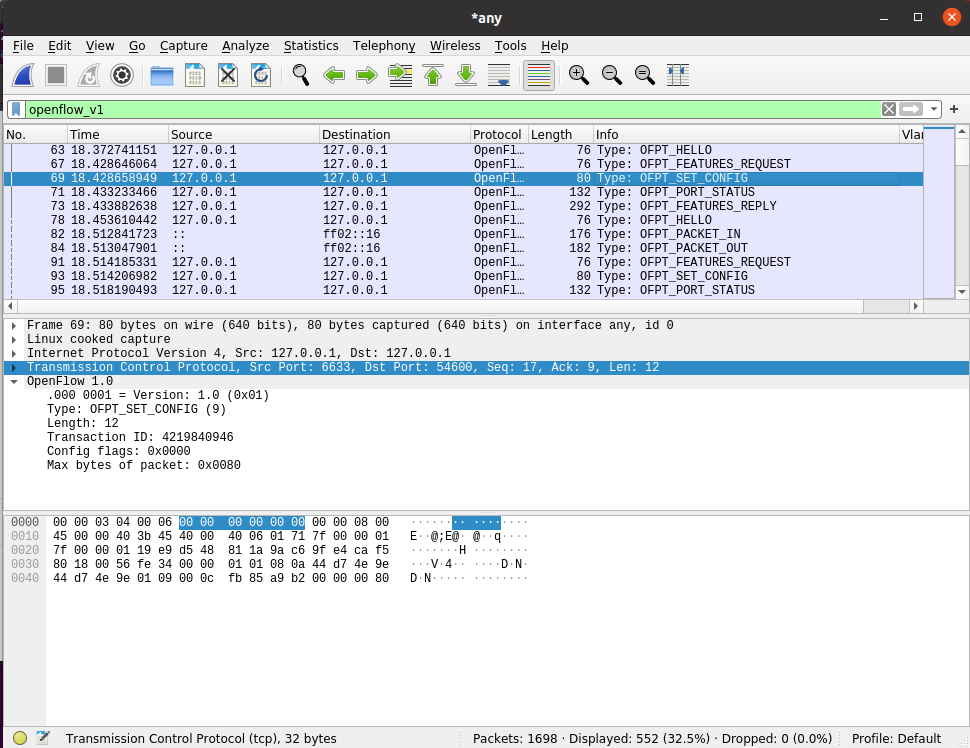
- 控制器端口(请按照我给你的flag和max bytes of packet进行配置) ---> 交换机端口
-
Port_Status
- 当交换机端口发生变化时,告知控制器相应的端口状态。
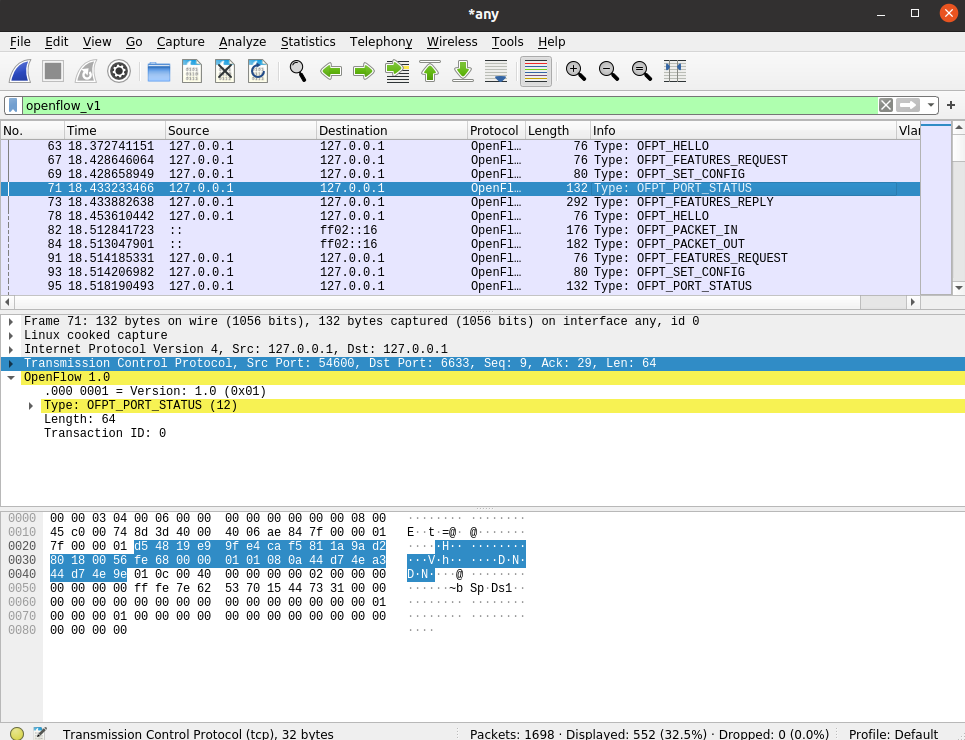
- 当交换机端口发生变化时,告知控制器相应的端口状态。
-
Packet_in
- 有匹配条目但是对应的action是OUTPUT=CONTROLLER时(在使用wireshark时未抓取到相应的包)
- 交换机查找流表,发现没有匹配条目时(图中可以看出,交换机发现此时自己并没有匹配的流表(Reason: No matching flow (table-miss flow entry) (0)),所以要问控制器如何处理)

-
Packet_out
- 控制器端口(请按照我给你的action进行处理) ---> 交换机端口

- 控制器端口(请按照我给你的action进行处理) ---> 交换机端口
-
Flow_mod
- 控制器通过6633端口向交换机54602端口下发流表项,指导数据的转发处理

- 控制器通过6633端口向交换机54600端口下发流表项,指导数据的转发处理

- 控制器通过6633端口向交换机54602端口下发流表项,指导数据的转发处理
3.回答问题:交换机与控制器建立通信时是使用TCP协议还是UDP协议?
- 如下图所示,可以很明显地看出,交换机与控制器建立通信时使用的是TCP协议

(二)进阶要求
1.将抓包结果对照OpenFlow源码,了解OpenFlow主要消息类型对应的数据结构定义。
- hello
-
wireshark截图对照

-
源码
-
/* Header on all OpenFlow packets. */
struct ofp_header {
uint8_t version; /* OFP_VERSION. */
uint8_t type; /* One of the OFPT_ constants. */
uint16_t length; /* Length including this ofp_header. */
uint32_t xid; /* Transaction id associated with this packet.
Replies use the same id as was in the request
to facilitate pairing. */
};
/* OFPT_HELLO. This message has an empty body, but implementations must
* ignore any data included in the body, to allow for future extensions. */
struct ofp_hello {
struct ofp_header header;
};
- Features Request
- wireshark截图

- 数据结构源码与hello一样,都是ofp_header
- wireshark截图
- set config
- wireshark截图

- 源码
- wireshark截图
/* Switch configuration. */
struct ofp_switch_config {
struct ofp_header header;
uint16_t flags; /* OFPC_* flags. */
uint16_t miss_send_len; /* Max bytes of new flow that datapath should
send to the controller. */
};
- Port_Status
- wireshark截图

- 源码
- wireshark截图
/* A physical port has changed in the datapath */
struct ofp_port_status {
struct ofp_header header;
uint8_t reason; /* One of OFPPR_*. */
uint8_t pad[7]; /* Align to 64-bits. */
struct ofp_phy_port desc;
};
- Features Reply
- wireshark截图
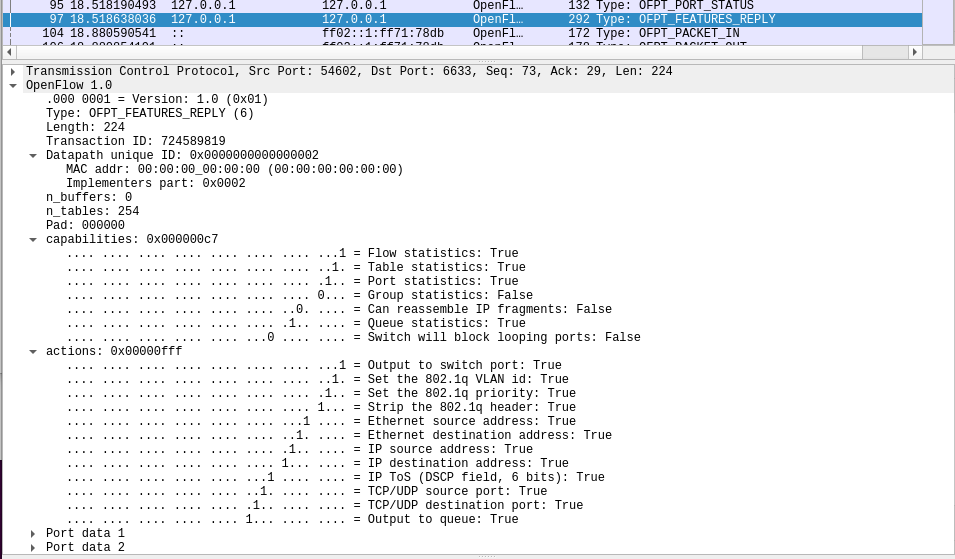
- 源码
- wireshark截图
/* Description of a physical port */
struct ofp_phy_port {
uint16_t port_no;
uint8_t hw_addr[OFP_ETH_ALEN];
char name[OFP_MAX_PORT_NAME_LEN]; /* Null-terminated */
uint32_t config; /* Bitmap of OFPPC_* flags. */
uint32_t state; /* Bitmap of OFPPS_* flags. */
/* Bitmaps of OFPPF_* that describe features. All bits zeroed if
* unsupported or unavailable. */
uint32_t curr; /* Current features. */
uint32_t advertised; /* Features being advertised by the port. */
uint32_t supported; /* Features supported by the port. */
uint32_t peer; /* Features advertised by peer. */
};
/* Switch features. */
struct ofp_switch_features {
struct ofp_header header;
uint64_t datapath_id; /* Datapath unique ID. The lower 48-bits are for
a MAC address, while the upper 16-bits are
implementer-defined. */
uint32_t n_buffers; /* Max packets buffered at once. */
uint8_t n_tables; /* Number of tables supported by datapath. */
uint8_t pad[3]; /* Align to 64-bits. */
/* Features. */
uint32_t capabilities; /* Bitmap of support "ofp_capabilities". */
uint32_t actions; /* Bitmap of supported "ofp_action_type"s. */
/* Port info.*/
struct ofp_phy_port ports[0]; /* Port definitions. The number of ports
is inferred from the length field in
the header. */
};
- Packet_in
- wireshark截图

- 源码
- wireshark截图
/* Why is this packet being sent to the controller? */
enum ofp_packet_in_reason {
OFPR_NO_MATCH, /* No matching flow. */
OFPR_ACTION /* Action explicitly output to controller. */
};
/* Packet received on port (datapath -> controller). */
struct ofp_packet_in {
struct ofp_header header;
uint32_t buffer_id; /* ID assigned by datapath. */
uint16_t total_len; /* Full length of frame. */
uint16_t in_port; /* Port on which frame was received. */
uint8_t reason; /* Reason packet is being sent (one of OFPR_*) */
uint8_t pad;
uint8_t data[0]; /* Ethernet frame, halfway through 32-bit word,
so the IP header is 32-bit aligned. The
amount of data is inferred from the length
field in the header. Because of padding,
offsetof(struct ofp_packet_in, data) ==
sizeof(struct ofp_packet_in) - 2. */
};
- Flow_mod
- wireshark截图
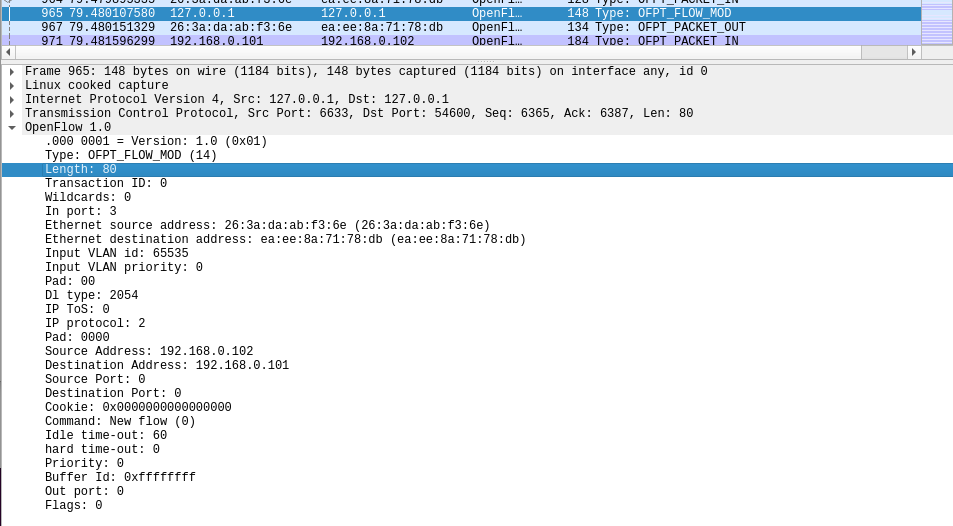
- 源码
- wireshark截图
/* Fields to match against flows */
struct ofp_match {
uint32_t wildcards; /* Wildcard fields. */
uint16_t in_port; /* Input switch port. */
uint8_t dl_src[OFP_ETH_ALEN]; /* Ethernet source address. */
uint8_t dl_dst[OFP_ETH_ALEN]; /* Ethernet destination address. */
uint16_t dl_vlan; /* Input VLAN id. */
uint8_t dl_vlan_pcp; /* Input VLAN priority. */
uint8_t pad1[1]; /* Align to 64-bits */
uint16_t dl_type; /* Ethernet frame type. */
uint8_t nw_tos; /* IP ToS (actually DSCP field, 6 bits). */
uint8_t nw_proto; /* IP protocol or lower 8 bits of
* ARP opcode. */
uint8_t pad2[2]; /* Align to 64-bits */
uint32_t nw_src; /* IP source address. */
uint32_t nw_dst; /* IP destination address. */
uint16_t tp_src; /* TCP/UDP source port. */
uint16_t tp_dst; /* TCP/UDP destination port. */
};
/* Flow setup and teardown (controller -> datapath). */
struct ofp_flow_mod {
struct ofp_header header;
struct ofp_match match; /* Fields to match */
uint64_t cookie; /* Opaque controller-issued identifier. */
/* Flow actions. */
uint16_t command; /* One of OFPFC_*. */
uint16_t idle_timeout; /* Idle time before discarding (seconds). */
uint16_t hard_timeout; /* Max time before discarding (seconds). */
uint16_t priority; /* Priority level of flow entry. */
uint32_t buffer_id; /* Buffered packet to apply to (or -1).
Not meaningful for OFPFC_DELETE*. */
uint16_t out_port; /* For OFPFC_DELETE* commands, require
matching entries to include this as an
output port. A value of OFPP_NONE
indicates no restriction. */
uint16_t flags; /* One of OFPFF_*. */
struct ofp_action_header actions[0]; /* The action length is inferred
from the length field in the
header. */
};
- Packet_out
- wireshark截图

- 源码
- wireshark截图
/* Action header that is common to all actions. The length includes the
* header and any padding used to make the action 64-bit aligned.
* NB: The length of an action *must* always be a multiple of eight. */
struct ofp_action_header {
uint16_t type; /* One of OFPAT_*. */
uint16_t len; /* Length of action, including this
header. This is the length of action,
including any padding to make it
64-bit aligned. */
uint8_t pad[4];
};
/* Send packet (controller -> datapath). */
struct ofp_packet_out {
struct ofp_header header;
uint32_t buffer_id; /* ID assigned by datapath (-1 if none). */
uint16_t in_port; /* Packet's input port (OFPP_NONE if none). */
uint16_t actions_len; /* Size of action array in bytes. */
struct ofp_action_header actions[0]; /* Actions. */
/* uint8_t data[0]; */ /* Packet data. The length is inferred
from the length field in the header.
(Only meaningful if buffer_id == -1.) */
};
四、实验心得
- 在本次实验中,对于控制层与数据层之间的南向接口以及两者之间在通信交互时传递的数据包,有了更加深入的理解。同时,也学习到,想要更深入地知悉相应数据包的功能,可以去查询相应源码,了解相应数据包结构体的参数。我认为本次实验属于中等难度,基本上大部分步骤根据实验指导书按部就班,都能完成得很顺利。
- 在实验过程中遇到的问题及解决
- 在一开始抓包时,因为题目要求是选择any选项去抓取所有的数据包,因此wireshark所抓取到的包非常多,在查阅起来有些困难。后来才发现可以通过过滤器对捕获的数据包进行适当的过滤,取出想要的那部分内容。
- 在进行数据包的参数分析时,一开始不知道wireshark界面上哪里才能查看各个数据包的参数取值情况。后来通过百度搜索引擎,才得知原来参数信息可以在wireshark的数据展示区最后一栏中查看。
- 在openflow.h中查找各个数据包对应的具体数据结构时,一开始找得并不是很顺利。毕竟是直接看源码,看得甚至有些头昏脑胀的。后面我通过仔细阅读老师给的实验指导书,同时找到源码后再次与实际数据包参数信息进行比对和验证,最后较为顺利地确认了各自数据包参数信息对应的数据结构,并更加清晰地理解了各个数据包的相应功能和相关参数。



 浙公网安备 33010602011771号
浙公网安备 33010602011771号